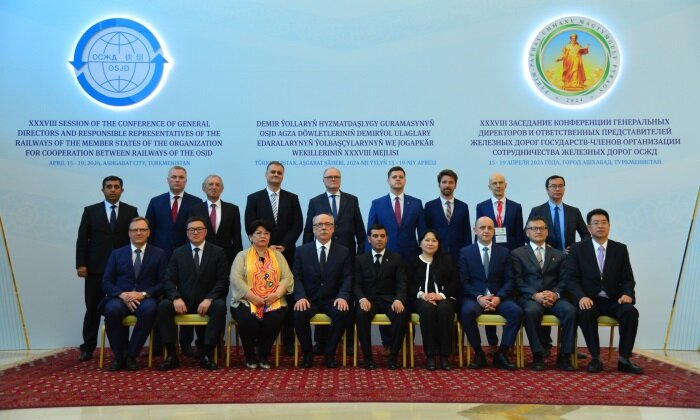Allaberdy Ilyasov described how the waste of mobile phones and electronic products can serve for the benefit of mankind and nature.
 In the Land of the Rising Sun, where the 2020 Summer Olympics took place, all gold, silver and bronze medals were made of metals obtained from the recycling of smartphones, tablets and other electronic devices handed over for recycling. Tokyo municipal authorities collected almost forty-eight tons of waste, and that let them make 30 kg of gold, 4100 kg of silver and 2700 kg of bronze, which almost completely covered the need for precious metals for medals.
In the Land of the Rising Sun, where the 2020 Summer Olympics took place, all gold, silver and bronze medals were made of metals obtained from the recycling of smartphones, tablets and other electronic devices handed over for recycling. Tokyo municipal authorities collected almost forty-eight tons of waste, and that let them make 30 kg of gold, 4100 kg of silver and 2700 kg of bronze, which almost completely covered the need for precious metals for medals.
Scientific analyst of CentralAsia.news, the well-known Turkmen scientist, Doctor of Technical Sciences and expert Allaberdy Ilyasov, in his new article, described in detail the problems existing in the field of accumulating electronic junk, and, in contrast, explained a method of solving it.
Good old gadget...
Today, the production of mobile phones does not stand still, new models are being developed and introduced at a rapid pace. Thus, a large number of obsolete telephones and other electronic devices increases. On our planet, end-of-life electronics account for about 2 percent of solid household and industrial waste. However, the percentage of such growth is gradually changing upward. In developed countries, the lifespan of computer equipment is decreasing.
Now in the United States, this period rarely exceeds two years, while ten years ago it was four to six years. At the same time, electronic waste cannot be called completely safe. Almost any electronics contain noticeable amounts of 6-valent chromium, antimony, cadmium. In general, there are not many of them, but if we take into account the scale, then the discarded equipment becomes, perhaps, the main source of these substances entering the soil and groundwater.
Global problem
More and more products such as smart refrigerators, freezers, washing machines, vacuum cleaners and others are expanding their connectivity in the growing Internet of Things. All in all, e-waste is a growing problem, the growth of which is comparable to the growth of the information and communications technology industry.
Inappropriate e-waste management can also contribute to global warming. And where is the way out of this situation? A variety of materials used in the manufacture of IT equipment can be collected and reused. They account for over 90% of the total weight of the equipment. Just imagine, as a result of processing one million cell phones, 15.8 tons of copper and 34 kg of gold can be recovered.
Creative solutions
An interesting approach in the fight for a healthy environment is used in Germany, where almost the entire population uses cellular communications, and to encourage people to hand over old models for recycling, many mobile operators accept phones for recycling by mail in special envelopes that can be ordered online with delivery to the house. This makes life much easier for the Germans and has positive results for the country as a whole.
In the United States, the recycling problem is solved by introducing a national program, the implementation of which is aimed at collecting unnecessary equipment. Points for receiving phones from the population have been created, part of the proceeds goes to charity.
In Japan, recycling is paid and this is enshrined at the legislative level. It is strictly forbidden to throw equipment in to a landfill — everyone is obliged to hand it over for recycling. For these purposes, special tanks, which are installed in supermarkets have been created. Conscientious Japanese are ready to pay for this service because clean air and a favorable environment are very important for them. In addition, in the country, the disposal of mobile phones is entrusted to the companies that produce them.
Situation-driven pragmatism
Global manufacturers do not neglect the opportunities provided by e-waste. For example, Dell launched the industry’s first program to recycle gold from the waste of electronic and electrical equipment. During the launch of the project in 2018, the company presented a collection of jewelry made of gold obtained from used motherboards.
Samsung also has a recycling strategy. Ericsson, which has also set up a system of free recycling points, claims that 98% of its recyclable materials can be recovered from used equipment.
In the overwhelming majority of developed countries, there is specialized legislation regulating the handling of electronic and electrical equipment waste. A UN study says that, for example, China has set the goal of reusing 20 percent of its old equipment by 2025.
European directives set not only some basic requirements for processing but also several benchmarks that EU states must achieve within a certain time frame. This legislation has resulted in a significant increase in the amount of e-waste which is properly collected and disposed of.
Time-consuming process
The technology of recycling mobile phones is a time-consuming process that requires a whole range of procedures. All work on the disposal of electronic equipment takes place in several stages since a mobile phone is a rather complex device, which consists of such parts as a case, a microcircuit, an antenna, a display, a microphone, and a battery. The composition of a modern phone includes plastic (45%), copper (20%), metals (20%), ceramics (10%) and other materials in the amount of five percent.
Phone cases are made of plastic, which has remained unchanged for hundreds of years, and electronic boards contain precious metals — gold, silver, copper, palladium.
Plastic components are used for different purposes: parts for various devices, building materials, plastic packaging, all kinds of spare parts.
Microcircuits, antennas, microphones can be used to develop new instrumentation and automation, or as a raw material for spare parts. Remelted metals are also used to craft new items. Precious metals are a special source of income. Their processing allows not only to preserve natural resources but also to reduce the cost of their extraction.
The short «life» of smartphones
Scientific and technological progress has led to the fact that the constant improvement of mobile phones and other gadgets leads to the accumulation of a large number of old models. Today man-made pollution caused by the negative impact of smartphones that have exhausted their resources on the environment is one of the world’s large-scale environmental problems.
Most of the «e-waste» is produced by Western Europe, Southeast Asia and the United States. Here, according to the observations of ecologists, the «service life» of IT equipment has recently decreased several times. Mobile phones «live» even less — «until a new model is released».
This explains the annual increase in computer and other electronic junk. Recycling rates are still low worldwide. Even in the EU, which leads the world in recycling such waste, only 35% are officially registered as collected and recycled correctly. On average around the world, this is 20%, the collection and recycling of the remaining devices within 80% is not documented, many of them are to be buried in landfills. And this type of garbage is not biodegradable.
Disposal standards
International waste management policy concerns the regulation of their import and export. In particular, e-waste is subject to the 1989 Basel Convention on the Control of Transboundary Movements of Hazardous Wastes and Their Disposal.
Also, the requirements of all sorts of standards play an important role in the relevant direction and they regulate not only the ergonomic characteristics of the equipment but also its energy consumption, the content of hazardous toxic, combustible materials, as well as the suitability for further disposal and recycling of materials.
This also includes the standards adopted by supranational entities, for example, the European Union, where a very tough continental directive concerning hazardous substances is in effect. And the rules that banned the use of soldiers containing lead contributed to the fact that these restrictions began to act de facto all over the world.
Therefore, the development of technologies should not harm the environment, this waste is dangerous: boards and circuits contain arsenic, lead and mercury.
Participation of Turkmenistan in the most important mission of humanity
Ecological problems are associated with the production of various wastes by mankind, which worsens the ecological situation. Proper recycling of household appliances is important to protect the environment in terms of shielding from the negative effects of hazardous materials, to save natural resources and money for various businesses. Recyclable materials can be used to produce new products much cheaper.
In this regard, the state environmental policy pursued by Turkmenistan is harmoniously combined with the policy of stable development of the world community and the protection of the ecosystems of the globe.
The conceptual goal of the environmental policy of the head of Turkmenistan, Gurbanguly Berdimuhamedov, is to solve problems that ensure environmentally-oriented economic growth, preserve natural resources, and strengthen the legitimacy in the field of environmental protection.
Following this path, in the modern history of the country, a set of laws in the field of nature protection was adopted. These are Laws «On ecological safety», «On nature protection», «On ecological expertise», «On chemical safety», «On ecological audit» and other regulatory documents.
Recycling all types of electronic devices at the end of their service life makes it possible to save resources and energy, and also contributes to the growth of the economy of Turkmenistan. It helps to create new jobs and protect the environment not only in Central Asia but throughout the planet as a whole.





